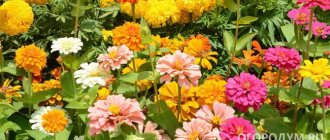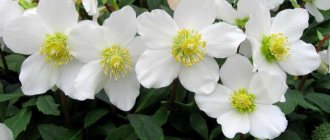One of the most common options for decorating a site is planting annual flowers. They are good because they bloom early, are easy to care for, and look bright and colorful. Seasonal flower beds are rarely complete without orange flowers - they attract the attention of passers-by and create a warm, sunny atmosphere. Orange color symbolizes energy and joy, so such annuals will not be out of place in any area!
Marigold
These flowers are extremely popular among summer residents and owners of private houses. They can also often be found in city flower beds, because they do not require complex care and always look very advantageous.
Of the large number of varieties, the most striking are the orange marigolds. They will be a wonderful decoration of the site, and will not require much effort in care. Marigolds can grow in almost any soil, but do not like excess moisture. Their flowering period is surprisingly long - orange flowers will delight residents and guests from May to September.
Monochrome
In this case, plants are selected in a common color scheme, differing in shade and lightness. Cuff, kupena, amaranth, and various decorative leaves: hostas, lungworts will look good. You can expand the range with colors of greenish-yellow and silvery-green shades. Achieving absolute monochrome is not easy: even when choosing plants with colored foliage, one cannot rule out the possibility that, under unfavorable circumstances, their leaves tend to revert to a “basic” green shade, writes Houzz.
Calendula
Calendula are annual flowers that are often orange in color. They are also known for their medicinal properties, but are most often used to decorate the local area.
Calendula blooms from July until frost, so brightness and beauty in the area will be ensured for a long time. It does not require careful care; the only requirement is that this plant should be provided with sufficient lighting.
Kalanchoe Blossfeld
This representative of the succulent family of plants is popular among many gardeners. This amazing flower combines beneficial properties, the beauty of inflorescences, luxurious thick leaves and unpretentiousness.
Kalanchoe Blossfeld accumulates moisture in its leaves and shoots, which is why it requires moderate watering. Prefers a moderate amount of light, so grows well in partial shade. If the plant does not have enough sun, it weakens, the leaves turn yellow and subsequently fall off.
Kalanchoe blooms all year round, with the exception of 1-2 months a year. However, for this he needs to provide:
- temperature regime. In summer – from 20 to 26 °C, in winter – 12-16 °C. When the temperature rises to +10 °C, Kalanchoe must be exposed to air. If the room temperature exceeds 26 °C, it should be watered abundantly;
- regular fertilization. The flower is fed with fertilizers intended for succulents. The winter period is an exception;
- Avoid spraying. It is recommended to wipe the leaves of Kalanchoe with a damp cloth, which is a preventive measure against spider mites and false cushions.
Attention! When fertilizing Kalanchoe, it is necessary to take into account that the composition for feeding is mixed exclusively in warm water. Then it needs to be cooled and only then added to the soil. Otherwise, the roots will not receive all the nutrients.
Viola
Viola or tricolor violet is a favorite of landscape designers. It is often planted in city flower beds and garden plots. Viola is widely used to create alpine slides and flower carpets, which makes it possible to observe its frequent and vigorous flowering.
10 shade-tolerant flowers to decorate “dark” corners of the site
Newly bred varieties allow you to arrange lush rainbow compositions. Orange flowers will give you a sunny mood throughout the summer.
Hypocyrtha flower naked
The plant belongs to the ampelous family and has flowers of various shades of orange. Hypocyrta has a spreading stem with oval leaves of a dark green color. The plant reaches a height of 50 cm. Owners of Hypocyrta can observe its flowering every spring.
Necessary growth conditions:
- frequent abundant watering;
- air humidity - up to 85%;
- bright lighting;
- location on the east or west side.
Interesting! With proper care, Hypocyrta naked can bloom again.
Gatsania
Gatsania appeared in Europe relatively recently. Since its homeland is Mozambique, in Russia you can hear another name for this flower - African chamomile. Bright orange flowers bloom by midday and delight with their beauty until the evening.
Today there are more than 40 varieties of this plant. It is increasingly found in front gardens and flower beds, as its brightness and colorfulness attracts many owners of personal plots.
Nematanthus
This flower is one of the representatives of the Gesneriaceae family, which has six species, represented by vines, shrubs and subshrubs. Some species of Nematanthus have a long stem, a thin long peduncle and bright green leaves. The flowers can be orange, pink, red or yellow.
The orange inflorescences in question are somewhat reminiscent of hypocyrta or columnea. Due to this, some of the species of this plant were included in this family. The homeland of nematanthus is South America, however, if the necessary conditions are met, it can grow quite actively in apartments.
Nematanthus care includes:
- compliance with temperature conditions. The flower loves warmth, so during the growing season the room temperature should be 19-28 °C in summer, and in winter (during the dormant period) - from 13 to 17 °C;
- lighting. Nematanthus requires bright lighting, including direct sunlight. Daylight hours are at least 12 hours. If the plant does not have enough sunny color, it weakens, the leaves change color;
- watering. During the active period, watering should be abundant and regular; it is required as the top layer of soil dries. During the dormant period, the frequency and volume of soil moisture should be reduced;
- humidity. Humidity level – up to 60%. It should be borne in mind that the lower the temperature in the room, the lower the humidity level should be and vice versa;
- fertilizer. Feeding is recommended only during the active period;
- location. East or west side.
Attention! During the active period, nematanthus requires daily spraying. To do this, use soft water at room temperature.
Nasturtium
Nasturtium or capuchin is a flower that provides a wide field for imagination. It masks unattractive and uneven areas of the territory, and also helps in creating cozy gazebos and verandas. This annual plant is most often grown in pots with drooping shoots and is usually planted in large quantities.
Tulips after flowering: 6 useful tips to save the bulbs
Combining orange with other colors
Blue-violet: annuals - Salvia uliginosa, Anchusa capensis, Brachycome, Felicia, Lobularia. Among the perennials we will name catnip (Nepeta) and lavender (Lavandula).
Yellow: rudbeckia (Rudbeckia, an annual variety, which, like perennials, has a brown “button” in the center of the yellow basket), sunflower, or heliopsis (Heliopsis), large-headed knapweed (Centaurea macrocephala), yellow-flowered marigolds (Calendula), feruleleaf string ( Bidens ferulifolia).
Grey-leaved: different varieties of Byzantine grass (Stachys byzantina), fragrant rue (Ruta graveolens, we especially recommend the compact variety 'Jackman's Blue'), annual bicolor ragwort (Senecio bicolor), different types of wormwood (Artemisia, among them the low-growing form of Schmidt's wormwood A.schmidtiana 'Nana'), evergreen heliotrope (Helictotrichon sempervirens), gray fescue (Festuca glauca).
Dorotheanthus
In mid-latitude climates it is grown as an annual. The spreading bush grows from 5 to 40 cm in height, so it is possible to choose a variety for different purposes - for cutting, decoration. The flowers (diameter 5-6 cm) differ in color; there are also two-color specimens. A flowerbed planted only with different varieties of dorotheanthus looks very picturesque and bright. When there is no sun, the flower closes. Blooms until frost.
Adonis spring (A. vernalis) and autumn (A. autumnalis)
Spring Adonis is a tall (up to 40 cm) perennial with large (8 cm) bright yellow flowers. In the autumn annual they are small (1.5 cm), yellowish or red, with a dark spot at the base. They are planted to decorate borders, lawns, rock gardens; tall ones are suitable for cutting. The flowering period is reflected in the name.
Arctotis
The varieties and varieties are represented by such a palette of colors that you can decorate the entire territory with only arctotis - the South African analogue of chamomile. Each peduncle bears one large flower up to 8 cm in diameter. The bluish-silver leaves add decorativeness. Low-growing (15 cm) varieties are planted in the foreground of medium-tall and tall crops, and tall (up to 1 m) varieties are suitable for creating a background for ground covers and beautiful compositions with deciduous perennials.
Gerbera
An original garden plant, the leaves of which are collected in a rosette, and the bright flower is located on a long (up to 60 cm) bare peduncle. The inflorescence basket is large (from 4 to 15 cm), the color of the petals is different: various shades of pink, orange, white, yellow. The dark center adds brightness and expressiveness. Flowering lasts 3-4 months.
Doronicum or gooseberry (Doronicum)
Flowers of this species can be called “suns” - they look so bright against the background of dark green leaves. The marginal flowers are always yellow, and the middle can be dark yellow or orange. Depending on the species, they are short - only 10-15 cm, high - up to 150 cm, the size of the inflorescence-basket is also different - from 4-5 cm to 10-12 cm.










